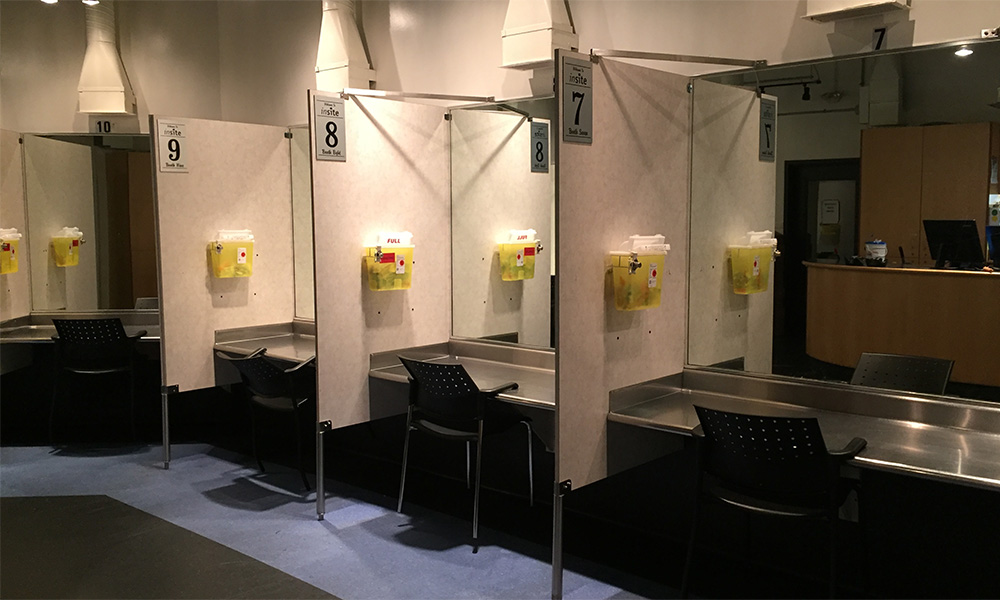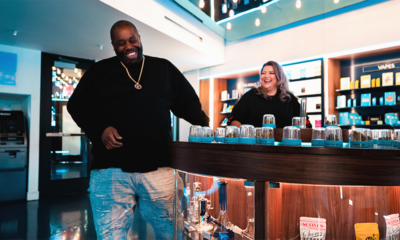
Politics
Cities Build ‘Safer Consumption Spaces’ for Opiates, But Not Cannabis
On Feb. 6, San Francisco voted to open “safer consumption spaces” where citizens can legally inject drugs of their choice. In Philadelphia and New York, advocates are pushing hard to open similar spaces. Unlike opiates, marijuana has yet to cause a fatal overdose — but in cities across the country, public places to legally consume cannabis remain elusive.
Lawmakers in cities across America are struggling to cope with the ongoing opioid crisis, and are looking toward “safer consumption spaces” — the more palatable and broader term for Safe Injection Facilities (commonly abbreviated as SIFs) — as a solution to the public health epidemic. The SIFs are intended intravenous drug users with clean and sanitary places to get high, while medical professionals supervise.
On Tuesday, San Francisco’s health commission voted unanimously to open SIFs in the city by July 1, 2018. Philadelphia officials announced at the end of January that they are moving forward with also opening SIFs in their city. And last week, New York State Assembly members and community leaders gathered in the capital city of Albany to re-launch a stalled legislative effort to create these safer consumption spaces.
But when they say “safer consumption spaces,” these lawmakers do not appear to be considering cannabis. San Francisco’s current plans include safe spaces for injection (of any substance). While some of San Francisco’s medical cannabis dispensaries provide on-site consumption for cannabis, the state of California doesn’t have provisions for adult use smoking lounges. Whether or not the proposed SCS/SIFs in New York will allow inhalation on site remains to be seen. Some facilities in other cities around the world allow smoking or inhalation of either cannabis, heroin or other drugs.
In New York State in particular, the opioid crisis has claimed the lives of more people than homicides, suicide and traffic accidents combined. Between 2015 and 2016, the overdose death rate increased by 32 percent in the United States; in New York City, it increased by a staggering 46 percent between 2016 and 2017.
“The opioid epidemic has New York State on the ropes, and we have an obligation to hit back with the most powerful tools in the harm reduction arsenal. Supervised Consumption Sites may not be a silver bullet, but across the world their record of saving lives is incredible – no one has ever died in a safer consumption site,” said New York State Assemblywoman Linda B. Rosenthal, Chair of the Assembly Committee on Alcoholism and Drug Abuse, who is working on a SIF initiative in the Empire State. “Addiction is a crippling disease that has touched too many families in our state, and we must open this pathway to treatment and recovery.”
“People are dying everyday and I need to know if you are ready to save lives.” – @Kassandra_Fred, @DrugPolicyOrg #EndOverdoseNY #YesToSCS pic.twitter.com/B2yAVBs2aC
— HRC (@HarmReduction) January 29, 2018
Many individuals who initially use prescription painkillers for an ailment or injury often end up getting hooked and turning to street drugs like heroin to continue using. Past studies have touted cannabis as a helpful tool in easing opioid addiction, especially for individuals suffering from chronic pain, but a new study released on Feb. 6 suggested that medical marijuana might not be clearly correlated to helping transition users off opioids.
At the Albany rally for SIFs, one New York representative named Diana Richardson spoke with all the conviction of a Southern Baptist preacher’s daughter in favor of SIFs. She told a captive audience that she is so opposed to society’s “NIMBY” attitude of “Not in My Back Yard,” and is so committed to “harm reduction and saving lives,” that she is willing to put a SIF in her own district, in her “backyard,” in Brooklyn. Her remarks were met with enthusiastic applause.
This type of “not in my backyard” phobia is a common theme when discussing safe injection sites. The fearful idea that if a SIF is locally implemented, heroin users will suddenly converge on their town en masse, like Coachella. However, those who are worried that SIFs will draw addicts to their communities often don’t realize that addicts have always been there, co-existing in the same communities. “They either haven’t seen them, or haven’t wanted to see them,” said a recovering user in the audience.
“Safer consumption sites are neither controversial nor new,” said Rosenthal. “The first safer consumption site began operating in 1986 in Berne, Switzerland. Since then, safer consumption sites have been opened in nearly 100 cities worldwide. They are a proven harm reduction method that saves lives.”
For example, staff at the Frankfurt, Germany SIF say that they provided lifesaving aid 3,180 times between 2000 and 2013, slashing the city’s overdose rate by 80 percent. The opening of the Vancouver, Canada safer consumption site contributed to a 35 percent reduction in overdose deaths.
According to the groups who are supporting this legislative initiative, letting heroin users cook and inject drugs in a supervised facility isn’t enabling or condoning their activities, but rather reducing the harm they are doing to themselves, and potentially to those around them, including spreading Hepatitis C via the dirty, bacteria-laden water that is used to liquefy heroin prior to its injection. SIFs often provide the opportunity to have drugs tested, so users can find out if their substances are laden with deadly fentanyl, and having the overdose-reversing drug Naloxone on site.
When the Albany rally’s emcee instructed everyone who knew someone who had died of an overdose, to please raise their hands, almost every hand in attendance immediately shot up.
“Countries around the world, including our [Canadian] neighbors to the North, have embraced the operation of Safer Consumption Spaces,” said Chief Brendan Cox, former chief of the Albany, New York Police Department. “These are medical facilities that allow people to utilize drugs in a safe, supervised environment. While this might be counter-intuitive and hard to wrap our heads around, we must remember this crisis requires us to stay focused on saving lives. There is no room for moral debates that delay life-saving interventions. Saving lives is our one and only priority.”
He stressed that the time has come to treat the crisis as a public health issue, rather than a criminal justice issue. While the research around the effectiveness of public health responses overwhelmingly shows positive results, the same does not hold true for criminal justice responses.
“Dating back to the 1970s, over 100 legally sanctioned Safer Consumption Spaces have opened in cities around the world. To date, there has not been one fatal overdose in any of these,” Cox continued. “While people are at the facilities, drugs can be tested to ensure they are not synthetically manufactured, medical needs can be addressed, counseling is available, and in some sites, detox centers are housed in the same building. This provides a crucial entry point for individuals who want immediate access to treatment.”
A harm reduction based approach to drug use is better for users, their families, and for our community. Harm reduction saves lives! https://t.co/VeCcwAAslv
— Harlem United (@HarlemUnited) February 2, 2018
Liz Evans, co-founder of InSite and Director of Washington Heights Corner Project/New York Harm Reduction Centers, concurred with Cox. She has had a dog in this fight, for 20 years, as InSite — based in Vancouver, Canada — opened in 2003 to become North America’s first legal medically supervised injection center (MSIC).
The Albany meeting fostered an atmosphere of a good-natured, mutual admiration society, between the speakers, with a bit of competitive showmanship. Quiet and mousy, Rosenthal’s comments were slightly overshadowed by the expressiveness of her more outgoing counterparts.
Once Housing Works President and CEO Charles King took the podium, it turned into a pulpit. He recited Proverbs 13:12: “Hope deferred makes the heart sick, but a longing fulfilled is a tree of life.”
“Supervised injection is about two things: saving lives and offering hope,” he said.
Despite all the speakers being on the same side of the issue, there was an underlying current of racial tension and resentment at the meeting. Alexis Pleus of Truth Pharm — whose son transitioned from prescription painkillers to street drugs and ultimately died of an overdose — said her son “would be alive today, if he had access to a safe consumption site.”
She provocatively asked if she lined up 100 lawmakers’ children in front of them, would they be okay with 10 of them dying without access to an SIF? When she innocently remarked that SIFs are necessary so that “all the Jeff’s, Johnny’s, Jason’s and Elizabeth’s lives wouldn’t be lost,” a supporter of the National Black Leadership Commission on AIDS angrily muttered under his breath, “and all the Anquistas and Shapiquas too.”
“I am pissed the f*ck off, that her son had to die upstate, for my people down here to start to get help,” said speaker Shantae Owens from Vocal-NY, after Pleus spoke.
However, the overall consensus of the press conference was, no matter what a user’s socio-economic background is, they do not need society’s punishment or judgment — they need help. San Francisco and Philadelphia have taken the lead, by moving to open the first SIFs in the United States. The collective groups in support of these centers hope New York won’t be too far behind.
TELL US, what do you think about safer consumption spaces?
























